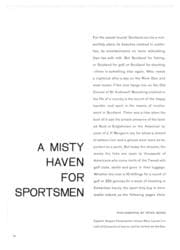
Hopkins lost a title and maybe a tradition
The old, old story of the good little man versus the good big man took an unexpected turn last week. The good little man was Dennis Wedekind, and he was remarkably good indeed, perhaps as good as any goalie has ever been on any Navy lacrosse team. Wedekind looked particularly small on the bare green expanse of Homewood Field at Johns Hopkins University, for he is only 5 feet 4 inches tall. Congress specifies that midshipmen at the Naval Academy must be at least 5 feet 4, and most of the men on Navy's lacrosse team stand 6 feet 2, 6 feet 3, and so on, and look like football players, which is what they are when they are not playing lacrosse.
Nevertheless, when Wedekind sprinted away from Navy's goal after a save, with the ball cradled in the rawhide thongs of his lacrosse stick, and raced down the field in a sort of composed frenzy, dodging two or three Hopkins defensemen, he gave such a clear demonstration of the art, excitement and mystery of this ancient Indian pastime that the occasion became historic. Not that he was alone in the demonstration. Jim Lewis, the Navy attack man, is said by people who have been watching lacrosse in Maryland for decades to be the best they have ever seen. Lewis is 5 feet 9 inches, weighs 190 pounds and is gifted with instant acceleration. Poker-faced and tirelessly aggressive, he suddenly materializes somewhere near the goal with the ball in his possession. Between them, Wedekind and Lewis did not seem to be beating Johns Hopkins. They seemed to be beating the game of lacrosse. But since lacrosse has been played at Johns Hopkins for 78 years and is the major sport there, that might amount to the same thing.
The Navy game this year had special significance for Johns Hopkins. It had an undefeated team and the intercollegiate championship was at stake. In addition, it was Homecoming, with red-buds and flowering dogwood on schedule brightening the handsome Baltimore campus that looks like a stage setting. There were 42 bright class banners around the walls of the gymnasium, beginning with the black-and-violet banner of 1882, and the sense of tradition was strong. Homecoming at Johns Hopkins is the sort of event at which some distinguished surgeon carrying a banner turns to a bystander and says, "We haven't had this big a turnout in a long time," taking it for granted that anyone there must be a member of his class. A benign scholar, with an unworldly expression on his features, wanders about asking everyone, "Where is 1915?"—a year that seems a long way away; in those days Hopkins was playing lacrosse with the Carlisle Indians.
As it was in 1915, however, lacrosse is part of the way of life at Johns Hopkins in 1965, though with sports de-emphasized, with no admissions charged to games and—more important—no athletic scholarships, the Hopkins students of 1965 probably are more aware of the unique character of their lacrosse traditions than were their predecessors 50 years ago. Lacrosse sets Johns Hopkins apart more now than it did then. Between 200 and 300 of the 1,500 undergraduates play lacrosse; there are at least 12 intramural games a week. What is more important is that few Hopkins men in the past took much interest in other sports. Hopkins has a football team, though it is a weak one in a weak league and has won only seven games in the past four years. There are also a basketball team and a baseball team, their status on campus even lower and their records no more inspiring to the student body as a whole. The baseball team was playing Western Maryland last Saturday as part of the same Homecoming celebration that featured the lacrosse game with Navy. It was a good baseball game, played on an easily accessible field within shouting distance of Homewood Field, where the lacrosse game was soon to start, but there were 12 spectators at the baseball game (which Western Maryland won 3-2 in the 10th) compared to 8,000 at the lacrosse game.
That is a fair measure of the different degrees of interest in these sports at Johns Hopkins, at least up to now, and it may be one of the things that Navy's success in beating the game of lacrosse has changed. Whatever else the Navy squad possessed, it had rounded athletic experience: seven of the first-string lacrosse team were on Navy's varsity football squad. As for Hopkins, traditions were gallantly upheld. Concentrating on lacrosse alone, its players had beaten Yale, Princeton, Virginia and Rutgers decisively, and upset a powerful Army team 6-3. It was that which made the Navy game the one that probably would decide the national championship.
True, Navy also beat Princeton, by a score of 17-9, compared to Hopkins' 10-6. The only other team they both met was Mount Washington. Here Hopkins won a surprisingly tough game 13-8 (with the score only 6-4 at the half), while Navy made it 21-1. But, on the other hand, few had given Hopkins a chance against Army. In fact, news of that Hopkins victory was generally disbelieved in Baltimore. The Baltimore Sun has been on strike for the past month, and when the reports spread by word of mouth that Hopkins had beaten Army it was considered another idle rumor. A week later Hopkins emerged strongly as a championship possibility with a 21-6 victory over Syracuse, and the stage was set for last week's Homecoming drama.
There is something inherently old-fashioned about lacrosse; it looks as if it ought to be illustrated by Currier and Ives. Its old-fashioned air, however, was entirely on the side of the Johns Hopkins upholders of tradition. Navy was devoted to efficiency, unhurried accuracy, the careful gaining of minute advantages and the scientific hoarding of them until they resulted in goals. At the face-off, for instance, Frank Szoka of Johns Hopkins, 5 feet 10,165 pounds, faced Stewart Overton of Navy, 6 feet 2, 191 pounds, a football tackle. The ball exploded into play, and Navy emerged in possession of it. This started something. In the first 13 face-offs in the first quarter Navy collected the ball 12 times. To get back to the first one—a minute and a half after Navy got possession, Jim Lewis materialized before the Hopkins goal with a short angling shot for the first score. On the second face-off Szoka faced Neil Henderson, 6 feet 2, 190 pounds, another football player. In fact, Navy had three midfields of equal ability, substituted with computerlike efficiency according to the situation or the Hopkins personnel involved. This time the process was interrupted when an agitated Hopkins junior, Lucky Mallonee (whose father was a famous star of the great 1928 team and is in the Lacrosse Hall of Fame) tried a bit of romantic derring-do with a long, forlorn run and a wild, hopeless shot. Hopkins' Stan Fine then got the ball by Wedekind to even the score.
This evoked a massive retaliation, ponderous and implacable. Brian Lantier, 6 feet 3, 185 pounds, another Navy football player, scored Navy's second goal, followed by one by Owen McFadden, then another by Lewis, then another by Lantier, to make it 5-1. Halfway through the first quarter the Hopkins stands had grown silent. The older members of the Hopkins community, speaking to a visitor watching his first lacrosse game, made such stoic comments as, "You won't often see a play like that." Or, when Lewis scored with a shot that was shoulder-high, an inch from the edge of the net, "What defense is there against that?"
Extreme specialization made the Navy attack seem even more overwhelming than it was. Near the end of the half the score was 7-4, not hopeless by any means, but in 14 face-offs Hopkins had collected the ball only twice and in the frantic brief scrambles over loose balls Navy had recovered most of them. The half ended with the score Navy 10, Hopkins 4. "A team sometimes comes from far behind in the second half in lacrosse," said one of the elder statesmen of Hopkins, "but not against Navy."
In a second half marked by excruciatingly long battles over loose balls, and a flare-up of frustration when Hopkins Defenseman Mike Oldnick and Navy Captain Brian Lantier fell to belaboring each other with lacrosse sticks and were ejected from the game, there were moments when it was not easy by any means for Navy. The old-fashioned, single-handed heroism of the Hopkins players' attack, and their marvelous passing, occasionally lifted the hopes of traditionalists. But more often a Hopkins attack ended in a spectacular save by Wedekind, followed by a spectacular reversal when he ran down the field to take a shot at the goal himself.
At the end the score of 15-6 was not so bad. It merely meant the end of Hopkins' hopes for a championship. It meant another national title for Navy; Army has already lost twice, so the outcome will not be affected by the forthcoming Army-Navy game.
What mattered most was the change in the Hopkins attitude toward lacrosse. One of the features of Homecoming was the dedication of the new Newton H. White Athletic Center, a magnificent $2.5 million structure. It caters to all the required lacrosse traditions—the Hall of Fame room, the old-fashioned stick carried by Father Bill Schmeisser in 1900—but it also has a superb swimming pool, so that Hopkins will now have one of the essentials for a swimming team. It also has a new gymnasium for the basketball team, and about every other sports facility that anyone would want. It points up the hard lesson that Johns Hopkins has learned: her athletes may have to master all modern sports in order to keep lacrosse alive.
PHOTO
PROTECTING THE BALL FROM HOPKINS' CHARLES PUGH, STAR NAVY ATTACK MAN JIM LEWIS CUTS DOWNFIELD TO SET UP A GOAL
PHOTO
PROUD STANDARD-BEARER, 89-YEAR-OLD MILTON W. POWELL JOINS HOMECOMING

